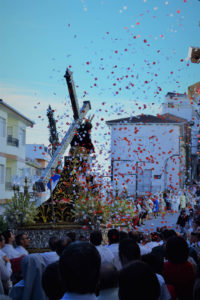What do Year 7 pupils think of RE? That it’s a ‘Touchy Subject’
01 August, 2019, Dr Kevin O'Grady

You might not think there’s anything touchy about the above photo. It’s a happy scene where a whole Spanish pueblo is out on a sunny September afternoon to celebrate one of the two annual occasions when their most loved religious image, Padre Jesús, is processed through the streets. Yet controversy’s rarely far beneath the surface when it comes to religion; and within the living memory of some of those in the procession, during the Spanish Civil War, the same image had to be hidden in a barn for three years to prevent anarchists and communists from destroying it. There’s an agreement amongst the villagers to try to forget about those events and not discuss them, which holds up most of the time.
Moving back into the RE classroom, it isn’t easy for teachers to handle the conflict dimensions of religions and worldviews with pupils. Moreover, we could do with knowing more about what pupils think about this element of RE. That’s why I hope you’ll forgive me for featuring recent research by myself, together with Bob Jackson, in this month’s blog. In a 2018 project, we worked with RE teachers in a South Yorkshire academy to create some research-enhanced pedagogy. We discussed some already published research with the teachers, in terms of how it might help to engage and stretch able Year 7 pupils within a topic on Christianity and the environment, and we assisted the teachers to re-plan some of the lessons on that basis. I then observed the lessons and gathered questionnaire and interview data from a pupil sample, later also interviewing some of the teachers about their experience of the project.
I can’t cover all our findings here but will give you some of the headlines. Firstly, some of the topic content was controversial (e.g. disputes between Christian groups around dominion or stewardship and conflicting pupil views over religion or the environment); clear, agreed ground rules for discussion meant that the controversies could be engaged without too much rancour or reduction, especially because the pupils helped decide the rules. Secondly, direct contact with members of faith groups made the RE more relevant and engaging for the pupils – they interviewed relatives or family friends that self-identified as Christian and reported back enthusiastically to the whole class at the start of the next lesson. Thirdly, small group discussion of Biblical texts was effectively supported by a hermeneutical questioning structure: what might this have meant when originally read or heard? What different interpretations are possible? How might people of different backgrounds or interests interpret it today? Fourthly, for the teachers, working with the researchers and research gave extra angles on teaching, built confidence, improved class management and was much more productive than the generic, data-driven CPD to which they had become used.
The description of RE as a ‘touchy subject’ comes from the pupil interview record. But the pupils also said that the chance to investigate difference (between religious and other views of the world, and between one another) is what makes RE valuable and interesting. For the teachers, thinking about research had enhanced their capacity to provide such interest and value to pupils. This is something we want to hear much more about at CStG.
You can read more about this research at ‘A Touchy Subject’: Year 7 pupils’ views on when RE is good (and RE teachers’ views on the benefits of engaging with research)
The reference for the full published article is: Kevin O’Grady & Robert Jackson (2019) ‘A touchy subject’: teaching and learning about difference in the religious education classroom, Journal of Beliefs & Values, DOI: 10.1080/13617672.2019.1614755
There may still be some free, open access downloads of the full article available via this link: https://www.tandfonline.com/eprint/hr8fZwcXS8VSH8izyItI/full?target=10.1080/13617672.2019.1614755